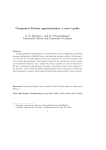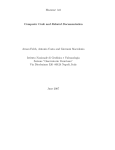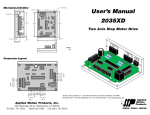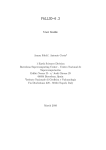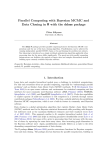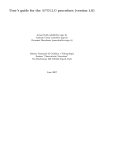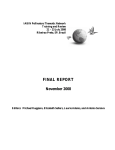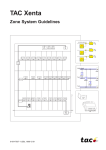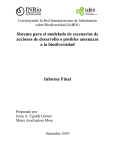Download PARFIT 2.1 user`s manual - Istituto Nazionale di Geofisica e
Transcript
PARFIT-2.1 A tool for the parametrization of volcanic ash deposits G. Macedonio(1), A. Costa(2) (1) Istituto Nazionale di Geofisica e Vulcanologia, Osservatorio Vesuviano, Napoli, Italy (2) Istituto Nazionale di Geofisica e Vulcanologia (INGV) Via Donato Creti 12 - 40128 Bologna, Italy February 2014 PARFIT 2.1 USER MANUAL 2 parfit code Copyright (C) 2014 Giovanni Macedonio, Antonio Costa. This program is free software: you can redistribute it and/or modify it under the terms of the GNU General Public License as published by the Free Software Foundation, either version 3 of the License, or (at your option) any later version. This program is distributed in the hope that it will be useful, but WITHOUT ANY WARRANTY; without even the implied warranty of MERCHANTABILITY or FITNESS FOR A PARTICULAR PURPOSE. See the GNU General Public License for more details. You should have received a copy of the GNU General Public License along with this program. If not, visit http://www.gnu.org/licenses/ 3 PARFIT 2.1 USER MANUAL Contents 1 Introduction 4 2 Description of parfit 2.1 How parfit works . . . . . . . . . . . . . . . . . . . . . . . . . . . . . . . . . . . . . . . . 4 4 3 Input files 3.1 The input file parfit.inp . . . . . . . 3.1.1 Block wind . . . . . . . . . . . 3.1.2 Block turbulence . . . . . . 3.1.3 Block column . . . . . . . . . 3.1.4 Block vent . . . . . . . . . . . 3.1.5 Block flags . . . . . . . . . . 3.2 The input file ground thickness.inp 3.3 The input file column spectrum.inp . 3.4 The input file ground spectra.inp . . 3.5 The optional input file wind.dat . . . . . . . . . . . . . . . . . . . . . . . . . . . . . . . . . . . . . . . . . . . . . . . . . . . . . . . . . . . . . . . . . . . . . . . . . . . . . . . . . . . . . . . . . . . . . . . . . . . . . . . . . . . . . . . . . . . . . . . . . . . . . . . . . . . . . . . . . . . . . . . . . . . . . . . . . . . . . . . . . . . . . . . . . . . . . . . . . . . . . . . . . . . . . . . . . . . . . . . . . . . . . . . . . . . . . . . . . . . . . . . . . . . . . . . . . . . . . . . . . . . . . . . . . . . . . . . . . . . . . . . . . . . . . . . . . . . . . . . . . . . . . . . . . . . . . 6 6 6 7 8 8 9 10 10 10 10 4 Output files 4.1 The output 4.2 The output 4.3 The output 4.4 The output . . . . . . . . . . . . . . . . . . . . . . . . . . . . . . . . . . . . . . . . . . . . . . . . . . . . . . . . . . . . . . . . . . . . . . . . . . . . . . . . . . . . . . . . . . . . . . . . . . . . . . . . . . . . . . . . . . . . 11 11 11 11 11 5 Compiling and installing parfit 5.1 Floating Point precision . . . . . . . . . . . . . . . . . . . . . . . . . . . . . . . . . . . . . 5.2 The Suzuki model . . . . . . . . . . . . . . . . . . . . . . . . . . . . . . . . . . . . . . . . 11 12 12 6 NOTE 12 file file file file parfit.out chi2.out . parfit.wnd parfit.cmp . . . . . . . . . . . . . . . . . . . . . . . . List of Figures 1 Wind profile generated by parfit. . . . . . . . . . . . . . . . . . . . . . . . . . . . . . . . 7 List of Tables 1 2 3 4 5 6 Sample Sample Sample Sample Sample Sample of of of of of of file file file file file file parfit.inp . . . . . . . ground thickness.inp column spectrum.inp . ground spectra.inp . . winds.dat . . . . . . . . parfit.out . . . . . . . . . . . . . . . . . . . . . . . . . . . . . . . . . . . . . . . . . . . . . . . . . . . . . . . . . . . . . . . . . . . . . . . . . . . . . . . . . . . . . . . . . . . . . . . . . . . . . . . . . . . . . . . . . . . . . . . . . . . . . . . . . . . . . . . . . . . . . . . . . . . . . . . . . . . . . . . . . . . . . . . . . . . . . . . . . . . . . 14 15 15 16 17 18 4 PARFIT 2.1 USER MANUAL 1 Introduction A common problem in volcanology is the description of the volcanic column and the ash transport mechanisms starting from the deposit generated by the eruption itself. Different models are available for solving the direct problem, that is to estimate the ash fall deposit starting from the total erupted mass, grain size distribution of the particles, wind field, atmospheric conditions, volcanic column height and shape (eg: FALL3D, HAZMAP, TEPHRA, etc.), however few methods are available for solving the inverse problem (eg: Pyle, 1989; Bonadonna et al., 1998). parfit belongs to the category of the solvers of this inverse problem, whose aim is to find the set of input parameters that minimize the difference between the simulated and the real deposits. parfit was designed for searching the best parameters (total mass, column height, the bulk granulometry, the mass distribution inside the column, wind profile and atmospheric diffusion coefficient), required by the computer code hazmap, for reconstructing the observed tephra deposits and granulometry spectra. However, the obtained results can be used also as input to other models. parfit was applied for the reconstruction of ash fall deposits the Plinian eruption of Vesuvius occurred in A.D. 472 (Bonasia et al., 2010). 2 Description of parfit parfit is a fortran code able to find the volcanic eruption parameters, starting from field data. On UNIX/Linux machines, parfit is executed by invoking the command parfit from the shell prompt. The code reads the control file (parfit.inp) where the user defines the domain of investigation of the eruption parameters and other computational flags (see Sec. 3.1), then it loads the thickness of the ground deposit measured in different stratigraphic sections (file ground thickness.inp), and performs a search on grid for finding the best parameters that fit the deposit using the model hazmap (Macedonio et al., 2005; Pfeiffer et al., 2005). If the bulk grain size distribution (ie: the grain size distribution in the eruption column) is known, it may be specified in the optional input file column spectrum.inp. Alternatively, the bulk grain size distribution is estimated by parfit starting from the size distributions at ground, defined in file ground spectra.inp. Results are printed on the screen and in file parfit.out). 2.1 How parfit works Input parameters required by Hazmap for reconstructing an ash fallout deposit produced by an explosive volcanic eruption can be obtained solving an inverse problem. Fitting is performed using a least-squares method which compares measured and calculated deposits thickness and grain-sizes. Because of the inherent limitation of the model to medium-range and distal parts of a deposit, only available data at a distance of at least few km from the eruption vent are considered. The function to be minimised (e.g Pfeiffer et al., 2005; Costa et al., 2009) is: N 1 X wi [Yobs,i − Ymod,i ]2 χ = N − p i=1 2 (1) where wi are weighting factors, N is the number of observed data, p is the number of free parameters, Yobs,i denote the observed ground load (kg/m2 ) and Ymod,i the values predicted by the model. The choice of the weighting factors, wi , depends upon the distribution of the errors (Costa et al., 2009). In order to well constrain the input parameters, it is necessary to know thickness and grain-size values in a large number, N , of stratigraphic sections, such as N ≫ p. For example, Pfeiffer and Costa (2004) showed that a good reliable inversion is given by at least 40-50 well distributed stratigraphic sections and at least 3-5 sections with individual granulometry and particle component distributions. However, especially for ancient eruptions, finding enough outcrops with a good exposure is often very arduous. There is a risk of finding parameters that result physically incorrect, especially when we deal with portions of the deposit, which represent the tail of the distribution relative to a particle class. In order to avoid these problems, in the scientific literature, other techniques for the calculation of the particles spectrum, in terms of the total grain-size distribution, were adopted, allowing the reduction of the degrees of freedom. 5 PARFIT 2.1 USER MANUAL Parfit-2.0 uses a new procedure which allows for fitting also the bulk grain-size distributions, even when only few stratigraphic sections are available. We assume that the best-fitted parameters such as column height, column shape coefficients, wind velocity and diffusion coefficient, do not vary with the choice of the grain-size classes. Thus, among all the possible choices, we focus on a restricted number of grain-size classes, for which the inverse problem results better constrained. In fact, in a first step, the program identifies the area enclosed by the measured ground sections, that is delimited by a “convex hull”. The calculation of the total mass at the ground is performed by summing the contribution of each particle type that leads to a Gaussian centre placed inside the “convex hull” of the measured ground-sections. This procedure allows for estimating the total mass relative to these classes only. In order to obtain the total mass over a wider range of grain-sizes, in a second step, we repeat the inversions fixing the values of column height, wind direction, wind speed and diffusion coefficients, as they were obtained in the previous step, and extend the computation of the bulk particle spectrum to the particles classes previously neglected, thus, leading to the final estimation of the effective total mass and of the total bulk velocity class distribution. The ash load at the ground is given by: # " X M i fj (x − xGi )2 + (y − yGi )2 (2) M (x, y) = 2 exp − 2 2πσi,j 2σi,j i,j 2 where σi,j is the thickness of the Gaussian relative to the particles that fall from the height zi with the settling velocity vj . It is related to the settling time and the diffusion coefficient by the relation: 2 σi,j = 2Kti,j . The particles settling velocity varies with the height. In order to take into account the variability of the particles velocity with height, it is defined the coefficient: b(i, j) = 1 1 dzk = P 4ti,j 4 k≤i vk,j (3) where dzi,j is the thickness of the layer k and vk,j the settling velocity of the particle of the class j into the layer k. The ground load is, then, given by: X Mi fj bi,j bi,j 2 2 exp − [(x − xGi ) + (y − yGi ) ] (4) M (x, y) = πK K i,j The mass distribution in real eruption columns is governed by complex physical processes that the model cannot account for. In order to consider a mushroom-like shape for the column, it is used an empirical formula modified from the original Suzuki formula (Suzuki, 1983): n oλ z z S(x, y, z, t) = S0 (1 − ) exp[A( − 1)] H H × δ(t − t0 )δ(x − x0 )δ(y − y0 ) (5) where S0 is the normalisation constant, x0 , y0 are the coordinates of the vent, H is the column height and A and λ are two empirical parameters introduced in Pfeiffer et al. (2005). The user defines the range and step of the eruption parameters. This defines a multidimensional grid generated by all the combinations of the parameters. parfit performs a search on the grid for the minimum χ2 between the simulated deposit simulated and the field data. Simulations are performed using the hazmap model (embedded in parfit). is based on hazmap, a computer program for simulating the ground deposit generated by the sedimentation of volcanic particles from an explosive eruption (Macedonio et al., 2005; Pfeiffer et al., 2005). 6 PARFIT 2.1 USER MANUAL 3 Input files 3.1 The input file parfit.inp File parfit.inp contains information for performing the search of the eruptions parameters and for controlling the output generated by parfit. This file is structured in blocks following the fortran namelists, easily readable from fortran codes. These blocks are: wind, turbulence, column, vent and flags. Each block begins with the directive &block name and ends with a slash “/”, where block name is the name of the block. The blocks must be written in the same order as specified before (see also Table 1). Each block contains a list of variables with associated their value. Comments start with the symbol “!” and are ignored. The name of the variables reflect the same name of the variable used in the fortran code. A sample of this file is reported in Table 1. 3.1.1 Block wind This is the first block of file parfit.inp. It begins with the directive &WIND and ends with a slash: “/” (see also Table 1). In this block, data referring to the generated wind profile are specified. The user may specify a single wind profile read from a file or specify some parameters used to generate a sequence of wind profiles for best fitting the deposit data. • rwindfile This flag selects weather a wind profile is read from file wind.dat (flag rwindfile = 0) or the wind profiles are generated using the other parameters defined below (flag rwindfile = 0). The structure of file wind.dat is specified in Sec. 3.5. • htropo This parameter is used when flag rwindfile=0 and specifies the height of the tropopause (in meters). In parfit, htropo coincides with the height where the wind has its maximum intensity. Fig. 1) shows the wind profile generated by parfit. According to Cornell et al. (1983), we assume that the wind speed increases from zero at sea level, up to its maximum at the height of the tropopause (parameter htropo), then its value is 75% of its maximum value. The wind profile is then multiplied by the the factor wnd and rotated along the vertical axis, towards direction dir (see (6) and (8)). • wndmin This parameter defines the minimum value of the wind intensity at tropopause (in m/s). The generated wind intensity values start from wndmin and increase by wndstep up to wndmax. • wndmax This parameter defines the maximum value of the wind intensity at tropopause (in m/s). The generated wind intensity values start from wndmin and increase by wndstep up to wndmax. If wndmin is equal to wndmax, then only one wind intensity is generated. • wndstep This parameter defines the increase step of the wind intensity at tropopause (in m/s). The generated wind intensity values start from wndmin and increase by wndstep up to wndmax. The value of wndstep should be equal to the difference (wndmax - wndmin) divided by an integer number (the number of steps -1). The generated sequence of wind intensities at tropopause (wnd) is: wndi = wndmin + i ∗ wndstep (i = 0, ..., nwnd) where nwnd is the number of generated wind directions: wndmax − wndmin nwnd = NINT wndstep and NINT represents the nearest integer. (6) (7) 7 PARFIT 2.1 USER MANUAL • dirmin This parameter defines the minimum value of the wind direction at tropopause (in degrees east). The generated wind direction values start from dirmin and increase by dirstep up to dirmax. The wind direction is the direction towards the wind blows; it starts from East (direction=0) and increases counter-clockwise (eg: a wind blowing from South has direction=90, and a wind from East has direction=180). • dirmax This parameter defines the maximum value of the wind direction at tropopause (in degrees east). The generated wind direction values start from dirmin and increase by dirstep up to dirmax. If dirmin is equal to dirmax, then only one wind direction is generated. • dirstep This parameter defines the increase step of the wind direction at tropopause (in degrees). The generated wind direction values start from dirmin and increase by dirstep up to dirmax. The value of dirstep should be equal to the difference (dirmax - dirmin) divided by an integer number (the number of steps -1). The generated sequence of wind directions (dir) is: diri = dirmin + i ∗ dirstep (i = 0, ..., ndir) (8) where ndir is the number of generated wind directions: dirmax − dirmin ndir = NINT dirstep (9) and NINT represents the nearest integer. 20 Z(km) 15 10 5 0 0.25 0.5 Wind speed (m/s) 0.75 1 Figure 1: Wind profile generated by parfit. 3.1.2 Block turbulence • cdmin This parameter defines the minimum value of the atmospheric diffusion coefficient (in m2 /s). The generated atmospheric diffusion coefficient starts from cdmin and increase by cdstep up to cdmax. 8 PARFIT 2.1 USER MANUAL The wind direction is the direction towards the wind blows; it starts from East (direction=0) and increases counter-clockwise (eg: a wind blowing from South has direction=90, and a wind from East has direction=180). • cdmax This parameter defines the maximum value of the atmospheric diffusion coefficient (in m2 /s). The generated wind direction values start from cdmin and increase by cdstep up to cdmax. If cdmin is equal to cdmax, then only one wind direction is generated. • cdstep This parameter defines the increase step of the atmospheric diffusion coefficient (in m2 /s). The generated diffusion coefficient start from cdmin and increase by cdstep up to cdmax. The value of cdstep should be equal to the difference (cdmax - cdmin) divided by an integer number. The generated sequence of atmospheric diffusion coefficients (cd) is: cdi = cdmin + i ∗ cdstep (i = 0, ..., ncd) where ncd is the number of generated wind directions: cdmax − cdmin ncd = NINT cdstep (10) (11) and NINT represents the nearest integer. 3.1.3 Block column • hcolmin This parameter defines the minimum value of the volcanic column height (in meters). The generated column height start from hcolmin and increase by hcolstep up to hcolmax. The column height is the height of the top of the column respect to the sea level. • hcolmax This parameter defines the maximum value of the volcanic column height (in meters). The generated column heights start from hcolmin and increase by hcolstep up to hcolmax. If hcolmin is equal to hcolmax, then only one column height is generated. The column height is the height of the top of the column respect to the sea level. • hcolstep This parameter defines the increase step of the eruptive column height (in meters). The generated column heights start from hcolmin and increase by hcolstep up to colmax. The value of hcolstep should be equal to the difference (hcolmax - hcolmin) divided by an integer number. The generated sequence of volcanic column heights (hcol) is: hcoli = hcolmin + i ∗ hcolstep (i = 0, ..., nhcol) where nhcol is the number of generated column heights: hcolmax − hcolmin nhcol = NINT hcolstep (12) (13) and NINT represents the nearest integer. 3.1.4 Block vent • xvent This parameter represents the X coordinate of the vent. Usually it is the East UTM coordinate of the vent. This parameter is not modified by parfit. PARFIT 2.1 USER MANUAL 9 • yvent This parameter represents the Y coordinate of the vent. Usually it is the North UTM coordinate of the vent. This parameter is not modified by parfit. • zvent This parameter represents the elevation of the vent above sea level. The generated column lies above the vent, between zvent and hcoli (see (12). This parameter is not modified by parfit. 3.1.5 Block flags • modew This parameter selects the χ2 weighting factors wi (see (1)): Flag: modew=0 Constant weighting factor (wi = 1). 2 Flag: modew=1 Proportional weighting factor (wi = 1/Yobs ). Flag: modew=2 Statistical weighting factor (wi = 1/Yobs ). • iflch This flag selects whether the maxima of the sub-deposits generated by each grain size class must lie in the convex hull (0=NO, 1=YES). • ifenl This flags allows the enlargement of the convex hull by the amount specified by parameter belthull (0=NO,1=YES). It has effect if iflch=1. • belthull This parameter specifies how much enlarge the convex hull, in meters. It has effect if both iflch=1 and ifenl=1. • iflwgt In case some ground sections do not have associated a particle grain size distribution, this flag allows the use of the grain size distrubution form the nearest point where it is available (0=NO, 1=YES). • vmodel This flag selects the settling velocity model: Flag: vmodel=1 Model of Arastoopour et al. (1982). Flag: vmodel=2 Model of Ganser (1993). Flag: vmodel=3 Model of Wilson and Huang (1979). Flag: vmodel=4 Model of Dellino et al. (2005). • ifvofz This flag selects whether the settling velocity is allowed to vary with the altitude: Flag: ifvofz=0 The settling velocity is evaluated at sea level and is assumed constant with height. Flag: ifvofz=1 The settling velocity is allowed to vary with the altitude, assuming that the variations of the density and viscosity of the atmosphere follow the International Standard Atmosphere (Smithsonian Institution, 1951). • ifchi This flag specifies whether the list of evaluated Ξ2 is printed in file chi2.out (0=NO, 1=YES). • ifgsp This file selects the method for handling the bulk grain size distribution in the column: ifgsp=0 - The whole grain size distribution in the column is read from file column spectrum.inp. PARFIT 2.1 USER MANUAL 10 ifgsp=1 - The grain size distribution in the column is estimated from best fitting the grain size distributions in the deposit sections, defined in file ground spectra.inp. 3.2 The input file ground thickness.inp This file defines the deposit sections: • The first record defines the number of ground sections specified below (variable npts). • npts records, each corresponding to a different ground section. Each record has the following fields: label of the section, X and Y UTM coordinates of the section, thickness of the deposit (metres), density of the deposit. A sample of file ground thickness.inp is reported in Table 2. 3.3 The input file column spectrum.inp This file is used if the bulk grain size distribution of the eruption column is known (flag ifgsp=0). This is equivalent to the bulk grain size distribution of the deposit. • The first record defines the number of particles classes (variable ntypes). • The following ntypes records refer to each particle class. Each record has four fields: diameter of the particle (metres), density of the particle (kg/m3 ), particle shape factor (adimensional, for spheres = 1), quantity of the particles (weight %). A sample of file column spectrum.inp is reported in Table 3. 3.4 The input file ground spectra.inp This file is used if the grain size distribution of the particles is specified in the deposit sections (flag ifgsp=1). • The first record defines the number of particles types (variable ntypes). • The following ntypes records refer to each particle type. Each record has three fields: diameter of the particle (metres), density of the particle (kg/m3 ), particle shape factor (adimensional, for spheres = 1). • Number of ground sections where the the particle type distribution is specified (variable nsect). • A number of block equal to nsect follows. Each block has the following structure: – Label of the section (corresponding to the same label defined in file ground thickness.inp). – List of ntypes records, each containing the mass fraction of the corresponding particle type in the section. These are specified in the same order as specified above. A sample of file ground spectra.inp is reported in Table 4. 3.5 The optional input file wind.dat The format of this file is the same as that used by hazmap. • Number of Z-layers (NZ). • A list of NZ records, each specifying the height of the Z-layer above sea level (in metres). • A list of NZ records, each corresponding to a different Z-layer. Each record has 6 fields: year, month, day, number of Z-layer, Vx, Vy. Where Vx and Vy are the components of the wind in the Z-layer toward X (East) and Y (North) A sample of file winds.dat is shown in Table 5. PARFIT 2.1 USER MANUAL 4 4.1 11 Output files The output file parfit.out File parfit.out contains the results of parfit, that is the parameters that minimize the discrepance between the simulated deposit and the field observation (minimum χ2 ). A sample of file parfit.out is reported in Table 6. 4.2 The output file chi2.out File chi2.out is generated when flag ifchi=1 in the input file parfit.inp. Thi file contains the complete list of χ2 scanned by parfit during the search of its minimum. This file has a number of records equal to the total combinations of parameters generated by parfit. Each record has the following 9 fields: Suzuki parameter A, Suzuki parameter λ, column height, wind intensity, wind direction, diffusion coefficient, beta, χ2 , number of particles types whose deposit has its baricenter inside the convex hull (variable nctypes). If flag iflch=0 (ignore the convex hull), then nctypes=ntypes. 4.3 The output file parfit.wnd File parfit.wnd contains the best wind found after minimizing the χ2 . It has the same structure of the input file winds.dat (see Sec. 3.5). However, the date of the wind is set to day=0, month=0, year=0. If the the input wind file is used (flag rwindfile=1), then parfit.wnd becomes a duplicate of file winds.dat. 4.4 5 The output file parfit.cmp Compiling and installing parfit parfit version 2.1 is written in fortran-90. To install parfit, uncompress and unpack the tar file parfit-2.1.tar.gz, then go to the parfit-2.1/src directory. gunzip parfit-2.1.tar.gz tar -xf parfit-2.1.tar cd parfit-2.4/src Now you should select the fortran compiler: edit the Makefile and set the variable FC must to the proper compiler. For example: # FC=ifort FCFLAGS= c fortran compiler ifort is specified. Another choice could be the gfortran In this case the Intel compiler: # FC=gfortran FCFLAGS= Additional compilation flags can specified by the variable FCFLAGS. For example, to activate the optimizer of the ifort compiler (flag -O) insert: # FC=ifort FCFLAGS= -O Now you are ready to compile parfit: just issue the command: make PARFIT 2.1 USER MANUAL 12 This generates the binary files parfit. By default, the executable is installed in the directory src. To check the installation, change directory to example under the directory parfit-2.1, and run ../src/parfit. The executable binary file parfit may be moved in your preferred PATH. Moreover, the input files parfit.inp, ground thickness.inp, ground spectra.inp and the optional file wind.dat can be modified to be adapted to the user. 5.1 Floating Point precision parfit-2.1 allows the complilation of subroutines and functions either assuming that floating point reals ar single or double precision. To switch between these, edit file src/kindtype.f90 and set the integer parameter SP as SINGLE or DOUBLE. Then issue the command make. 5.2 The Suzuki model parfit may be compiled using the standard Suzuki model (subroutine suzuki.f90), or its integrated version (subroutine isuzuki.f90 + function igamma.f90). To switch between the two versions uncomment the corresponding list of linked object(s) in file src/Makefile (parameter SUZUKIMODEL). 6 NOTE parfit-2.1 uses the following public domain routines: • To define the properties of the U.S. Standard Atmosphere 1977, parfituses subroutine atmosphere written by Ralph Carmichael, Public Domain Aeronautical Software, 2009 (freely available at http:///www.pdas.com). • To define the convex hull of the sampled ground points, parfit uses algorithm 523 by W.F. Eddy, ACM TOMS 3 (1977) 411-412, available at URL http://www.netlib.org (TOMS, algorithm 523). Here, algorithm 523 was translated in F90 and is contained into subroutines convex.f90 and split.f90. Acknowledgments We thank R. Bonasia for testing the code and suggestions that greatly improved the code. This work was partially supported by the Italian Department of Civil Protection (INGV-DPC Agreement 2007-2009, Project V5 - “SPeeD”). References Arastoopour, H., Lin, S., Weil, S., 1982. Analysis of vertical pneumatic conveying of solids using multiphase flow models. AIChE J. 28, 467–473. Bonadonna, C., Ernst, G., Sparks, R., 1998. Thickness variations and volume estimates of tephra fall deposits: the importance of particle Reynolds number. J. Volcanol. Geotherm. Res. 81, 173–187. Bonasia, R., Macedonio, G., Costa, A., Mele, D., Sulpizio, R., 2010. Numerical inversion and analysis of tephra fallout deposits from the 472 AD sub-Plinian eruption at vesuvius (Italy) through a new best-fit procedure. J. Volcanol. Geotherm. Res. 189, 238–246. Cornell, W., Carey, S., Sigurdsson, H., 1983. Computer simulation and transport of the Campanian Y-5 ash. J. Volcanol. Geotherm. Res. 17, 89–109. Costa, A., Dell’Erba, F., Di Vito, M., Isaia, R., Macedonio, G., Orsi, G., Pfeiffer, T., Apr. 2009. Tephra fallout hazard assessment at the campi flegrei caldera (italy). Bull. Volcanol. 71 (3), 259–273. PARFIT 2.1 USER MANUAL 13 Dellino, P., Mele, D., Bonasia, R., Braia, L., La Volpe, R., 2005. The analysis of the influence of pumice shape on its terminal velocity. Geophys. Res. Lett. 32 (L21306). Ganser, G., 1993. A rational approach to drag prediction of spherical and nonspherical particles. Powder Technol. 77, 143–152. Macedonio, G., Costa, A., Longo, A., 2005. A computer model for volcanic ash fallout and assessment of subsequent hazard. Comput. Geosci. 31, 837–845. Pfeiffer, T., Costa, A., 2004. A numerical reconstruction of fall deposits from Agnano-Montespina (4100 BP) Plinian eruption in the Campi Flegrei area. Tech. Rep. OV Prot. N. 4440 (10.11.2004), Osservatorio Vesuviano-INGV, http://www.earth-prints.org/handle/2122/2068. Pfeiffer, T., Costa, A., Macedonio, G., 2005. A model for the numerical simulation of tephra fall deposits. J. Volcanol. Geotherm. Res. 140, 273–294. Pyle, D., 1989. The thickness, volume and grainsize of tephra fall deposits. Bull. Volcanol. 51, 1–15. Smithsonian Institution, 1951. Smithsonian meteorological tables, 6th edition. Washington, D.C. Suzuki, T., 1983. A theoretical model for dispersion of tephra. In: Shimozuru, D., Yokoyama, I. (Eds.), Arc Volcanism: Physics and Tectonics. Terra Scientific Publishing Company (TERRAPUB), Tokyo, pp. 93–113. Wilson, L., Huang, T., 1979. The influence of shape on the atmospheric settling velocity of volcanic ash particles. Earth Planet. Sci. Lett. 44, 311–324. 14 PARFIT 2.1 USER MANUAL Table 1: Sample of file parfit.inp ! ! EXAMPLE OF FILE parfit.inp (Version 2.1) ! &WIND ! OPEN WIND BLOCK rwindfile = 1 ! Read file wind.dat [0=NO, 1=YES] htropo = 11000. ! Height of the tropopause (m) wndmin = 40. ! Min wind intensity (m/s) wndmax = 45. ! Max wind intensity (m/s) wndstep= 5. ! Step of the wind intensity (m/s) dirmin = 24. ! Min wind direction (degrees) dirmax = 26. ! Max wind direction (degrees) dirstep= 2. ! Step of wind direction (degrees) / ! CLOSE WIND BLOCK ! &TURBULENCE ! OPEN TURBULENCE BLOCK cdmin = 4000. ! Horizontal diffusion coefficient cdmax = 4000. cdstep = 500. / ! CLOSE TURBULENCE BLOCK ! &COLUMN ! OPEN COLUMN BLOCK hcolmin = 20000. ! Min column height hcolmax = 20000. ! Max column height hcolstep = 500. ! Column height step suz1min = 4. ! Suzuki coefficient N.1 (A) suz1max = 4. suz1step = 0.5 suz2min = 1. ! Suzuki coefficient N.2 (Lambda) suz2max = 1. suz2step = 0.5 / ! CLOSE COLUMN BLOCK ! &VENT ! VENT BLOCK xvent = 451737. ! Coordinates of the vent yvent = 4519302. zvent = 0. ! Elevation of the vent above sea level / ! CLOSE VENT BLOCK ! &FLAGS ! FLAGS BLOCK modew = 0 ! Chi2 weighting mode [0-2] iflch = 1 ! Check if gauss maxima are in convex hull [0-1] ! ifenl = 0 ! Enlarge the convex hull [0=NO,1=YES] belthull= 1000. ! How much enlarge the convex hull (m) ! iflwgt = 1 ! Use nearest points for spectra vmodel = 1 ! Settling velocity model ifvofz = 1 ! Flag: Vsettl. is a function of Z ifchi = 0 ! Write file chi2.out (0=NO, 1=YES) ifgsp = 1 ! Use file column_spectrum.inp/ground_spectra.inp / ! CLOSE FLAGS BLOCK 15 PARFIT 2.1 USER MANUAL Table 2: Sample of file ground thickness.inp 14 A01 A02 A03 A04 A05 A06 A07 A08 A09 A10 A11 A12 A13 A14 455906. 461855. 459513. 459015. 457470. 469247. 465646. 471913. 460309. 461577. 480443. 475851. 478215. 464973. 4525476. 4521650. 4521538. 4516330. 4516554. 4531112. 4526071. 4524904. 4521504. 4522298. 4528885. 4526648. 4526671. 4532304. 0.199 0.652 0.764 0.085 0.115 0.194 0.508 0.317 0.739 0.737 0.186 0.253 0.194 0.066 1000. 1000. 1000. 1000. 1000. 1000. 1000. 1000. 1000. 1000. 1000. 1000. 1000. 1000. Table 3: Sample of file column spectrum.inp 10 3.900e-6 7.800e-6 15.62e-6 31.25e-6 62.50e-6 125.0e-6 250.0e-6 500.0e-6 1.000e-3 2.000e-3 1400 1400 1400 1400 1400 1700 1700 2500 2500 2500 1.0 1.0 1.0 1.0 1.0 1.0 1.0 1.0 1.0 1.0 6.17 9.26 10.49 12.35 16.67 12.35 11.11 6.17 6.79 8.64 # # # # # # # # # # # NTYPES (number of particle types listed below) Diameter(m), density, shape, wt% Diameter(m), density, shape, wt% Diameter(m), density, shape, wt% Diameter(m), density, shape, wt% Diameter(m), density, shape, wt% Diameter(m), density, shape, wt% Diameter(m), density, shape, wt% Diameter(m), density, shape, wt% Diameter(m), density, shape, wt% Diameter(m), density, shape, wt% 16 PARFIT 2.1 USER MANUAL Table 4: Sample of file ground spectra.inp 10 3.900e-6 7.800e-6 15.62e-6 31.25e-6 62.50e-6 125.0e-6 250.0e-6 500.0e-6 1.000e-3 2.000e-3 2 A02 0.0614 0.0712 0.0379 0.0242 0.0512 0.0702 0.1254 0.1462 0.1978 0.2146 A13 0.1361 0.1477 0.0844 0.0581 0.4767 0.0953 0.0012 0.0002 0.0002 0.0003 1400 1400 1400 1400 1400 1700 1700 2500 2500 2500 1.0 1.0 1.0 1.0 1.0 1.0 1.0 1.0 1.0 1.0 # # # # # # # # # # # # # NTYPES Diameter(m), density, shape Diameter(m), density, shape Diameter(m), density, shape Diameter(m), density, shape Diameter(m), density, shape Diameter(m), density, shape Diameter(m), density, shape Diameter(m), density, shape Diameter(m), density, shape Diameter(m), density, shape NSECT (number of ground sections) LABEL Section 1 # LABEL Section 2 17 PARFIT 2.1 USER MANUAL Table 5: Sample of file winds.dat 40 500. 1000. 1500. 2000. 2500. 3000. 3500. 4000. 4500. 5000. 5500. 6000. [ ... 26 records deleted ] 19500. 20000. 1986 8 21 1 1.661 0.740 1986 8 21 2 3.322 1.479 1986 8 21 3 4.983 2.219 1986 8 21 4 6.644 2.958 1986 8 21 5 8.305 3.698 1986 8 21 6 9.966 4.437 1986 8 21 7 11.627 5.177 1986 8 21 8 13.288 5.916 1986 8 21 9 14.949 6.656 1986 8 21 10 16.610 7.395 1986 8 21 11 18.271 8.135 1986 8 21 12 19.932 8.874 [ ... 26 records deleted ] 1986 8 21 39 27.406 12.202 1986 8 21 40 27.406 12.202 18 PARFIT 2.1 USER MANUAL Table 6: Sample of file parfit.out Parfit version: 2.1 Using wind file: winds.dat Number of ground sections: 14 Using particles spectra from file: ground_spectra.inp Number of sections with spectrum: 3 Section: A02 Sum: 1.00010 Section: A13 Sum: 1.00020 Section: A14 Sum: 0.99990 Check for maxima inside convex hull: YES List of vertices of the convex hull A14 464973.0 4532304.0 A01 455906.0 4525476.0 A05 457470.0 4516554.0 A04 459015.0 4516330.0 A13 478215.0 4526671.0 A11 480443.0 4528885.0 Number of tests: 1 FLAG: B CHI2: 0.99421 TOTMASS: 0.56648E+09 VOL(DRE): 0.21788E-03 (km3) HCOL: 20000.0 CSUZ1: 4.000 CSUZ2: 1.000 CDIFF: 4000.0 P-TYPE wt% Vset (at sea level) 9 52.563 6.7938 10 47.437 11.013 SUM: 100.000 WARNING: Min. chi2 lies on parameters borders BDRY: CSUZ1 4.00000000000000 BDRY: CSUZ2 1.00000000000000 BDRY: COLUMN HEIGHT 20000.0000000000 BDRY: DIFF. COEFF. 4000.00000000000 PT Vset(sealev) X_mass Y_mass Distance OUT 1 0.64772E-03 291694979.4 134189328.5 318805492.5 OUT 2 0.25877E-02 73322233.5 36963382.6 79766707.5 OUT 3 0.10324E-01 18684857.3 12637221.6 19958639.5 OUT 4 0.40473E-01 5071057.4 6575958.9 5056476.8 OUT 5 0.14985 1670156.4 5061778.1 1333726.4 OUT 6 0.56111 757398.7 4655391.6 334588.4 OUT 7 1.3913 566784.6 4570524.6 125935.4 OUT 8 3.6853 492991.9 4537669.9 45159.2 IN 9 6.7938 473674.9 4529069.4 24014.0 IN 10 11.013 464440.6 4524958.0 13905.8


















